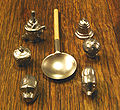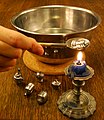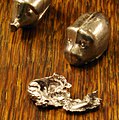Molybdomancy
Molybdomancy (from ancient Greek μόλυβδος - molybdos "lead"[1] + mancy, probably after Greek μολυβδομαντεία - molybdomanteia or French molybdomancie[2]) is a technique of divination using molten metal. Typically molten lead or tin is dropped into water.
Background
The method originates in ancient Greece[3] and today it's a common New Year tradition in the Nordic countries and Germany (German: Bleigießen, "lead pouring"), Switzerland and Austria, known as Silvester.[4] Classically, tin is melted on a stove and poured into a bucket of cold water. The resulting shape is either directly interpreted as an omen for the future, or is rotated in a candlelight to create shadows, whose shapes are then interpreted. Molten lead is also poured into water in a ritual in Turkey used when people have been affected by the evil eye,[5] and a similar traditional practice is used in Bosnia and Herzegovina.[6]
In Finland, shops sell ladles and small bullions in the shape of a horseshoe for this express purpose. Originally made from tin, now they are made from cheaper low-melting alloys based on lead. The practice is known as uudenvuodentina.[3] World's largest uudenvuodentina, 41 kilograms (90 lb), was cast by members of the Valko volunteer fire department in Loviisa, Finland, in New Year 2010.[7][8]
The shapes are often interpreted not only literally, but also symbolically: a bubbly surface refers to money, a fragile or broken shape misfortune. Ships refer to travelling, keys to career advancement, a basket to a good mushroom year, and a horse to a new car.[9]
Gallery
-
Set of lead pieces and spoon
-
Melting process
-
The lead after dropping into water
Notes
- ^ μόλυβδος, Henry George Liddell, Robert Scott, A Greek-English Lexicon, on Perseus
- ^ Molybdomancy, Oxford Distionaries
- ^ a b "New Year's Tin". tin-mhjk.blogspot.com. Retrieved 28 September 2015.
- ^ "SILVESTER - NEW YEAR'S EVE". mrshea.com. Retrieved 2015-12-31.
- ^ pp. 233 ff., Healing Secular Life: Loss and Devotion in Modern Turkey, Christopher Dole, University of Pennsylvania Press, 2012, ISBN 0812206355.
- ^ "Traditional Medicine in the Pristine Village of Prokoško Lake on Vranica Mountain, Bosnia and Herzegovina", Broza Šarić-Kundalić et al., Scientia Pharmaceutica 78, #2 (2010 June 30), pp. 275–290, doi:10.3797/scipharm.1003-06.
- ^ "Maailman suurin uudenvuoden tina valettiin Loviisassa". iltalehti.fi. Retrieved 28 September 2015.
- ^ Valkon VPK valoi maailman suurimman uudenvuoden tinan 41 kg. YouTube. 1 January 2010. Retrieved 28 September 2015.
- ^ http://www.rakentaja.fi/artikkelit/723/uudenvuoden_taikoja.htm
References
- de Givry, Grillot (1931). Witchcraft, magic & alchemy. Courier Dover Publications. p. 303. ISBN 0-486-22493-7.
- Cosman, Madeleine Pelner; Jones, Linda Gale. Handbook to life in the medieval world. Infobase Publishing. p. 434. ISBN 0-8160-4887-8.



